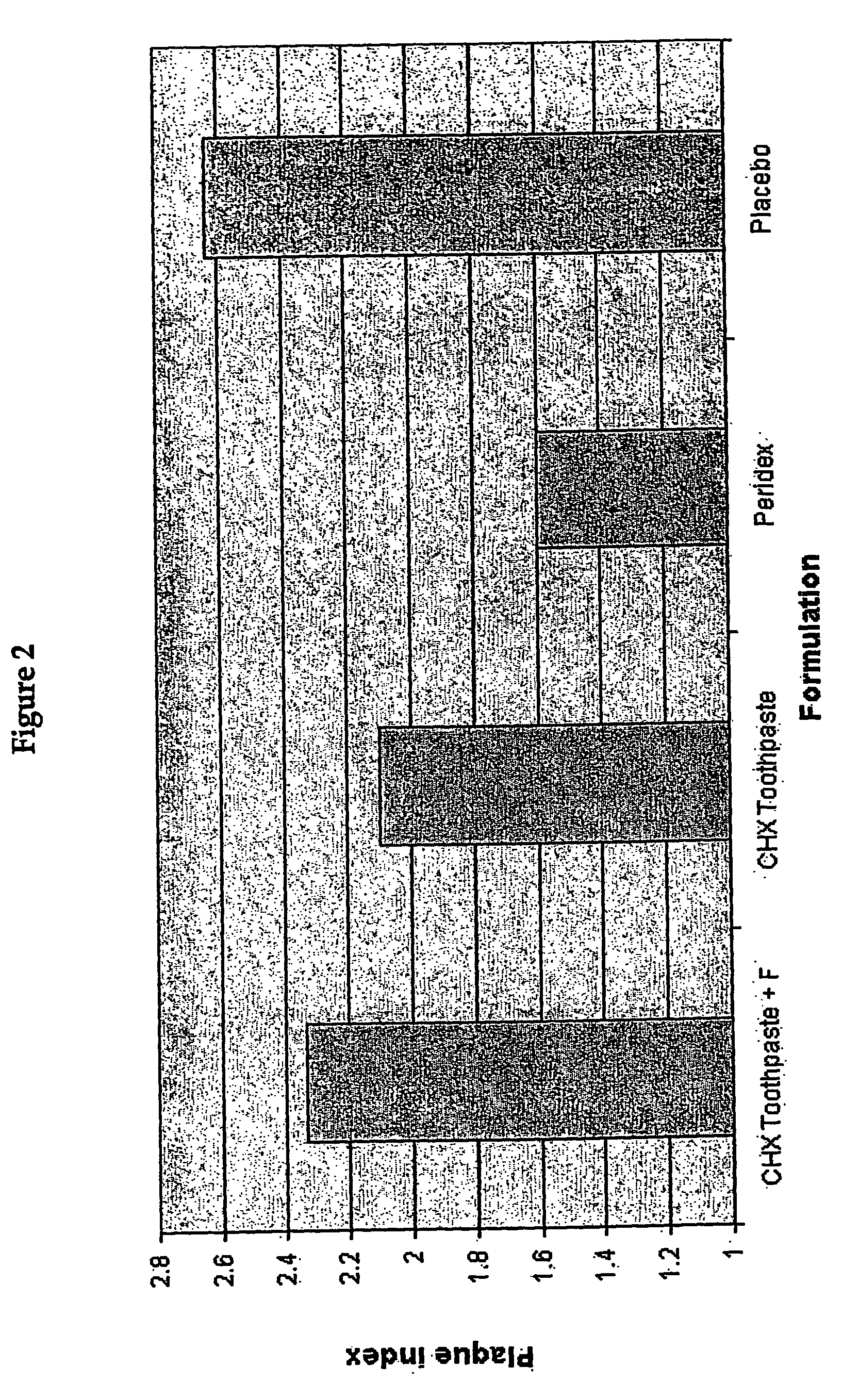Novel anti-bacterial compositions
a composition and antibacterial technology, applied in the field of new formulations, can solve the problems of difficult to achieve the effect of reducing bioactivity, soft plaque structure, and easy to be disturbed by chlorhexidine or its salts in oral hygiene products,
- Summary
- Abstract
- Description
- Claims
- Application Information
AI Technical Summary
Benefits of technology
Problems solved by technology
Method used
Image
Examples
example 1
Toothpaste Formulation
[0073] A typical toothpaste formulation according to the present invention is prepared as described below:
%COMPONENTw / wALCOHOL 95%7.5-10 1FUMED SILICA0.8-5.02COCAMIDOPROPYL BETAINE0.53CETEARETH 301.24CHLORHEXIDINE DIGLUCONATE SOLUTION3.195520% W / VHYDRATED SILICA 5-206HYDROXY ETHYLCELLULOSE0.5-5.07METHYL para HYDROXYBENZOATE0.18METHYL SALICYLATE0.159NEOHESPERIDINE DIHYDROCHALCONE0.01-0.1 10PROPYL HYDROXY BENZOATE0.0511SACCHARIN SODIUM0.01-0.0512SORBITOL SOLUTION 70%45.013WATER PURIFIEDqs 10014XYLITOL2.515ZINC GLUCONATE0.1-1.016PEPPERMINT OIL0.417
Method
[0074] A. Dissolve, with stirring, components 3, 4, 8, 9, 10, 11, 12 and 17 in alcohol 1. Finally add component 7 and continue to stir.
[0075] B. To an appropriate quantity of purified water 14 add components 15,16 and then 13. Stir to dissolve, and then add component 5. Continue stirring until a clear solution is obtained.
[0076] C. To the above solution B add components 2 and 6 and mix well with gentle stirr...
example 2
Toothpaste Formulation
[0077] The formulation is similar to that of Example 1, except that 0.01-0.22% w / w of sodium fluoride is added to the aqueous phase B.
example 3
Clinical Studies
Introduction
[0078] A study was carried out in the Department of Dentistry, University of Adelaide, in conjunction with Hamilton Laboratories, to test the effect of a new formulation of a toothpaste containing chlorhexidine (CHX) gluconate (as per Example 1) on dental plaque formation. Slurries of the toothpastes being tested were prepared and used as rinses, with subjects abstaining from mechanical plaque control for 4 days. The slurry method is used because mechanical plaque control alone, performed by a skilled person, would reduce dental plaque formation, with or without the use of a toothpaste or antibacterial agent. A commercial Oral Rinse (mouthwash) formulation from Zila Inc (Peridex, containing 0.12% w / w chlorhexidine gluconate solution) was chosen as a positive control because of its well documented ability to suppress plaque formation.
Methods
Subjects
[0079] Volunteers participating in the study were non-smokers, in good general health and included bo...
PUM
| Property | Measurement | Unit |
|---|---|---|
| w/w) | aaaaa | aaaaa |
| w/w | aaaaa | aaaaa |
| aggregation | aaaaa | aaaaa |
Abstract
Description
Claims
Application Information
 Login to View More
Login to View More - R&D
- Intellectual Property
- Life Sciences
- Materials
- Tech Scout
- Unparalleled Data Quality
- Higher Quality Content
- 60% Fewer Hallucinations
Browse by: Latest US Patents, China's latest patents, Technical Efficacy Thesaurus, Application Domain, Technology Topic, Popular Technical Reports.
© 2025 PatSnap. All rights reserved.Legal|Privacy policy|Modern Slavery Act Transparency Statement|Sitemap|About US| Contact US: help@patsnap.com


